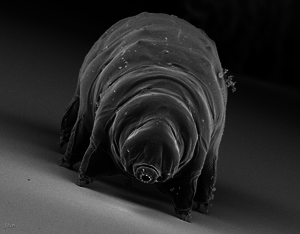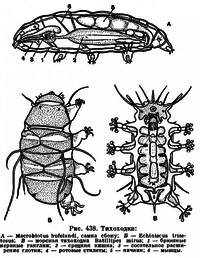Milnesium tardigradum: Difference between revisions
(Created page with "==Introduction== thumb|300px|right| Tardigrades (also commonly called “water bears”) are micro-animals that are known for being extremophiles, orga...") |
No edit summary |
||
| Line 1: | Line 1: | ||
{{Uncurated}} | |||
==Introduction== | ==Introduction== | ||
[[File:Tardigrade.png|thumb|300px|right|]] | [[File:Tardigrade.png|thumb|300px|right|]] | ||
Latest revision as of 14:28, 1 October 2015
Introduction
Tardigrades (also commonly called “water bears”) are micro-animals that are known for being extremophiles, organisms that can survive in conditions where most life on Earth would be unable to live. They get the nickname “water bear” from their eight-legged bear-like appearance and walk and the fact that they are commonly found in water (although they can be found anywhere from mountaintops to desert sand dunes).
Milnesium tardigradum is probably the most known tardigrade, and what it’s most known for is its ability to survive in the vacuum of space.
Classification
Domain: Eukarya
Kingdom: Animalia
Phylum: Tardigrada
Class: Eutardigrata
Order: Apochela
Family: Milnesiidae
Genus: Milnesium
Species: M. tardigradum
Anatomy
Most tardigrades are too small to see clearly, but M. tardigradum has been known to grow as large as 1.2mm long. It consists of a head, three body segments (each with a pair of legs), and a posterior segment with a fourth set of legs. The rear legs are used mainly for grasping objects and climbing while the front three pairs of legs are used for basic movement. M. tardigradum contains no respiratory organs and relies on gas exchange through its entire body.
Tardigrades are often classified by their claw shape and size, and the unique claws of M. tardigradum separate it from other tardigrades.
History
Tardigrades were first discovered in 1773, but M. tardigradum wasn’t found until 1840. It was located in the sea around Antarctica by the French zoologist Louis Michel Francais Doyere (1811-1863). M. tardigradum is sometimes referred to as “Milnesium tardigradum Doyere.”
Habitat and Diet
M. tardigradum can be found all over the world, but thrives in moist climates. It can often be found growing on mosses and lichens. It is carnivorous and consumes microscopic rotifers nematodes. Although M. tardigradum prefers water, it is very well adapted to surviving without it. M. tardigradum can survive extreme desiccation (water-loss) by entering a dormant state until environmental conditions become favorable.
Extreme Conditions
During 2007, M. tardigradum was exposed to the vacuum of space (and the cosmic radiation that comes with it) and survived. In space they suffered extreme dehydration and cosmic/solar radiation. Amazingly, M. tardigradum is so good at surviving extreme climates that it is able to function after being rehydrated after being in a vacuum, making it one of the very few living organisms that can survive in space.
References
Suzuki, Atsushi C. "Life History of Milnesium Tardigradum Doyère (Tardigrada) under a Rearing Environment." Zoological Society of Japan (2003): 49-57.www.bioone.org. Jan. 2003. Web. 07 Oct. 3013.
Beltrán-Pardo E, Jönsson KI, Wojcik A, Haghdoost S, Harms-Ringdahl M, et al. (2013) Effects of Ionizing Radiation on Embryos of the Tardigrade Milnesium cf. tardigradum at Different Stages of Development. PLoS ONE 8(9): e72098. doi:10.1371/journal.pone.0072098 06 Sept. 2013. Web. 07 Oct. 2013.
Welnicz, Weronikia, Markus A. Grohme, Lukasz Kaczmarek, Ralp O. Schill, and Marcus Frohme. "Anhydrobiosis in Tardigrades-The Last Decade." Journal of Insect Physiology (2011): 577-83. Web. 21 Oct. 2013.
Jonsson, Ingemar, Elke Rabbow, Ralph O. Schill, Mats Harms-Ringdahl, and Petra Rettberg. "Tardigrades Survive Exposure to Space in Low Earth Orbit." Current Biology 18.17 (n.d.): 729-31. 9 Sept. 2008. Web. 21 Oct. 2013.
Guidetti, Roberto, Tiziana Altiero, and Lorena Rebecchi. "On Dormancy Strategies in Tardigrades." Journal of Insect Physiology 57 (2011): 567-76. 12 Mar. 2011. Web. 21 Oct. 2013.
Guidetti, Roberto, Angela Maria Rizzo, Tiziana Altiero, and Lorena Rebecchi. "What Can We Learn from the Toughest Animals of the Earth? Water Bears (tardigrades) as Multicellular Model Organisms in Order to Perform Scientific Preparations for Lunar Exploration." Planetary Space Science 74 (n.d.): 97-102. 7 June 2012. Web. 21 Oct. 2013.


